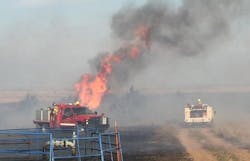On Tuesday, March 22, 2016, a wildfire that reportedly began along Anderson Creek near Freedom, OK, would be fueled by extreme weather conditions to become the largest wildfire in recorded Kansas history. Before it was fully contained 14 days later, the wildfire had consumed 367,620 acres, killing hundreds of cattle, destroying more than 40 buildings and bridges, forcing the evacuation of towns, and causing millions of dollars in damage.
Primed for conflagration
Wildfires are nothing new to firefighters in south-central Kansas, in the area commonly known as the Red Hills. Springtime prescribed burns restore prairie grasses and assist in controlling the spread of unwanted brush and invasive trees. The rugged terrain of this area does not fit most people’s image of Kansas, with red tinted soil, gypsum rich hills, plateaus and box canyons. The area is largely open ranchland used to graze cattle, in addition to hosting numerous oil and gas wells. Barber County, which was most impacted by the fire, has a population of around 5,000 people spread across farms, ranches and small communities.
The fire’s intensity was fueled by eastern red cedar trees, which once were limited to canyons and areas along creeks, and have rapidly spread across grasslands in the central plains. Between 2005 and 2015, the number of cedars in Kansas increased from an estimated 55 million to 85 million, according to the Kansas Forest Service. This has vastly increased the fire load and changed the nature of wildfires through much of the state.
The Anderson Creek fire spread quickly north through dry grass and canyons choked with eastern red cedars. The extremely low humidity and fuel moisture, coupled with high winds gusting to near 60 mph, caused spot fires to form up to three-quarters of a mile behind firefighters. Their efforts were also hampered by the area’s unforgiving terrain and lack of roads, which forced fire trucks to detour miles out of their way to try to establish defensive lines ahead of the fire. Just after dusk on March 22, the fire crossed the border and moved into Kansas and through Ted Turner’s 42,479-acre Z Bar Ranch.
Initial response
Barber County firefighters had already been fighting their own large wildfire near Sharon, KS, for more than 24 hours when Oklahoma authorities called to tell them that the Anderson Creek fire was moving their way.
Exhausted volunteer firefighters worked with ranchers, many of whom were their neighbors and relatives, to protect farmsteads as the fire moved around them. After midnight, Barber County was able to marshal more than 20 fire trucks to make a stand along U.S. Highway 160, more than 30 miles north of where the fire had started. Firefighters attempted to use backfires along the highway to starve the oncoming head fire of fuel. However, as daylight broke, firefighters realized that the fire had worked its way past the highway, burning up canyons and hopping over the firebreak to continue north toward small communities along the Medicine Lodge River.
At this point, the wind did the worst thing it could—it shifted from the west, causing a 35-mile-long head fire to surge east across Barber County. As the fire rapidly burned across the county, it formed numerous head fires, burning “dirty” and leaving large areas of fuel still unburned in its wake, which would hamper efforts to extinguish the blaze in the following weeks.
Communication and coordination
As the fire overran Barber County’s west fire UHF radio repeater site and later the east UHF fire repeater site, command and control of fire units, which had already been severely strained, was broken. Communication between fire apparatus was limited to line of sight, which was severely limited due to the rough terrain.
At the County Sheriff’s Department, dispatchers no longer had a way to relay the frantic 9-1-1 reports they were receiving to firefighters in the field. While sheriff deputies would fall back to using the statewide 800-MHz radio system, firefighters did not have that capability. Fire units worked with those units that were nearby to defend structures in the path of the fire, but there was little overall coordination of their efforts. Additionally, there was no accountability for resources and firefighters from the many mutual-aid agencies who had sent fire crews to the assist with the fire. Preparations were made to evacuate the county seat of Medicine Lodge.
Barber County authorities, who are no strangers to large wildfires, quickly realized that this fire was different and that they needed more assistance than they could gather from surrounding counties, many of which were dealing with their own wildfires. By coincidence, the Kansas Forest Service had gathered its fire management resources to conduct live-fire training with Hutchinson Community College fire science students over spring break. This allowed the Forest Service to quickly deploy its Type III Incident Management Team, hand crews and four wildland engines to Medicine Lodge. While responding, they realized that the fire had grown so large that it was forming its own pyrocumulus clouds, formed by intense heating of the air from the surface.
In addition, Barber County requested that the Kansas Division of Emergency Management (KDEM) dispatch a state Type III All-Hazards Incident Management Team (AHIMT) to complement the Forestry IMT. The AHIMT includes leaders from a number of disciplines, including emergency management, fire, law enforcement, emergency medicine, public health and private industry. While this team has experience responding to large-scale disasters—such as helping tornado-damaged towns and supporting communities impacted by floods, and they had conducted training on wildfires—they had not actually deployed for a wildfire before. The advanced team for the IMT arrived late on Wednesday, March 23, and the team started operations early on Thursday, March 24.
As the sun rose on Thursday, the teams worked to try to gain an idea of the scope of the fire and how many fire resources would be needed. Local firefighters were completely exhausted, and their equipment was suffering from constant use under terrible conditions. The west fire tower had been restored, and efforts were underway to restore the east radio tower site. In the meantime, the state had dispatched a “Communications on Wheels” semi-truck with a 100-foot radio tower, a cache of portable radios and a radio site networked by satellite uplink to the state radio system. This allowed portable 800-MHz radios to be distributed to each fire apparatus working the fire along the estimated 67 miles of line in Barber County. Unfortunately, due to the rough terrain and Barber County’s location on the south edge of the state radio system, firefighters quickly found that the 800-MHz radios were unreliable. The majority of field communications that day among the command post in Medicine Lodge, division supervisors in the field and their fire units was accomplished via cell phone and text messaging, which also faced coverage issues.
Making headway
The Kansas Highway Patrol was able to get a small observation airplane over the fire scene on Thursday morning to identify priority areas for fire crews. This was the first opportunity commanders had to measure the extent of the fire. The western flank of the fire, located in Cherokee County, was determined to be largely contained. However, the aircraft was only able to fly a single observation mission before weather conditions made flight too hazardous.
The challenge for firefighters on this day and subsequent days was maintaining the outer perimeter of the fire while also responding to fires in unburned “islands” of vegetation inside the fire’s perimeter that were threatened as the wind switched directions again, now from the north. Firefighters were forced to defend some homesteads over several days as the wind shifted and the fire approached from different directions and traveled up previously unburned canyons. To exacerbate the lack of access roads, the fire had destroyed a number of timber construction bridges, further limiting access, especially to larger fire apparatus and water tenders.
Firefighters did an excellent job on Thursday of holding the fire’s spread to the southeast as they held a line along Hardtner Cutoff Road. Flame heights reached 80 to 100 feet as firefighters were assisted by farmers using large discs to create a fireline along the road as a large head fire moved out of a canyon, burned rapidly through heavy fuel, and threatened to jump the road. Firefighters worked through heavy smoke and radiant heat conditions to quickly extinguish spot fires, stopping the fire at the road.
On Saturday, March 26, weather conditions improved enough for the 1st Battalion, 108th Aviation Regiment, Kansas Army National Guard to deploy four UH-60 Black Hawk helicopters outfitted with water buckets to assist with the fire. Fortunately, the Kansas Forest Service team included several members who had experience with coordinating airdrops and acting as ground guides for the firefighting aircraft.
On Saturday and Sunday, National Guard Black Hawk helicopters dropped an estimated 68,000 gallons of water on hot spots. The helicopters were especially useful in reaching fires that were burning in canyons firefighters were unable to reach on the ground. Helicopters were also used to patrol the fire perimeter, using their thermal imaging systems, to identify problem areas.
On Sunday morning, the weather finally cooperated with firefighters, dumping several inches of wet snow over Barber County. Between the snow, which had melted by noon, the helicopters airdrops and firefighters working the line, the command post was able to announce that evening that the fire was 81 percent contained in Barber County and 90 percent contained overall. Incident Management Team resources began to demobilize and return to their home agencies.
Firefighters get the job done
In all, over the first six days of the fire, 184 public safety agencies provided mutual-aid resources to Barber County. This was a huge undertaking for a state where 90 percent of firefighters come from volunteer or mostly volunteer departments. Citizens of Barber County were extremely appreciative of the efforts of firefighters and volunteered to provide meals and run base camps for the out-of-town firefighters. Efforts are now underway through agricultural and community support groups to organize volunteers to remove and replace damaged fencing for impacted ranchers.
About the Author

Mark Engholm
Mark Engholm has 23 years of experience with local, state and federal law enforcement and 26 years in the fire service. He serves a Squad Leader and Relief Duty Officer with the Shawnee Heights Fire District near Topeka, KS. Engholm has been a member of the Kansas All Hazards Incident Management Team since 2007 and has qualified as both a Type III operations section chief and Type III public information officer. He served as a deputy operations section chief for the Anderson Creek Fire.
